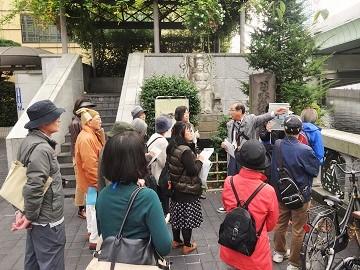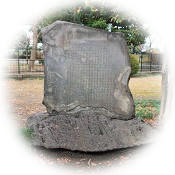 "Autumn Cultural Properties Tour" sponsored by the Chuo-ku Board of Education, which tours cultural properties such as historical heritage inside and outside the city by bus and foot.
"Autumn Cultural Properties Tour" sponsored by the Chuo-ku Board of Education, which tours cultural properties such as historical heritage inside and outside the city by bus and foot.
This year, on October 29 and November 5, Shinichiro Iwakiri was invited as a lecturer, entitled "About Printing Culture from Edo / Meiji to Showa". .
Visit the land related to the printing culture from Edo and Meiji eras to modern times and learn about the transition.
 The process of the day is
The process of the day is
① Nihonbashi neighborhood (Otohime's Square - Waterfall Square - Flower Square
~ Plaza of the original mark ~ Edo Sakura-dori St. <Surugacho> ~ Money Museum
~ Joban Hashikado Ruins ~ Ichiishibashi ~ Yumeji / Minatoya-related land ~
Nipponbashinishi Riverside Jizo-ji Church
② Ningyocho neighborhood (Sugimori Shrine-Sakaimachi, Fukiya-cho play town ruins-
Ruins of Genji Store-Sanko Inari Shrine
③ Mukaishima Sankai Shrine, Sumida-ku (Kuniyoshi Utagawa Honoring Monument)
④ Bunkyo-ku Water Works Print Museum (special exhibition "Samurai and Printing")
First of all, there are many publishers such as local wholesalers and woodblockers living in the neighborhood, and along with economy and finance, stroll through the Nihonbashi area, which was also a cultural center. In line with the theme, we listened to episodes of Okura Bookstore (published by Soseki Natsume's "I am a cat") located at Nihonbashi 1-chome <Nishikawagishicho> corner, and at the currency museum, the Edo period clan bills, the "watermark" technique that partially thinned fibers, a special printing of foreign characters that are difficult to recognize, and a multi-colored print.
Continue walking around the Ningyocho area around the Genji store, where Kuniyoshi Utagawa, a representative of ukiyo-e artists from the late Edo period, was said to have temporarily lived.
In the afternoon, first visit the Kuniyoshi Utagawa Honoring Monument in Mukojima, Sumida-ku, which was erected by his disciples in 1873, the 13th anniversary of Kuniyoshi, followed by Kuniyoshi's warrior painting, which is also exhibited. To the "Print Museum" in Bunkyo Ward Waterway.
Currently, special exhibition "Samurai and Printing" is being held.
In the Edo period, ukiyo-e paintings depicting brave samurai appeared, while the samurai was involved in intellectual publishing such as maps and translations, a special exhibition that introduces the two aspects of the samurai through contrasting printed materials.
In addition to a collection of about 150 works centered on Kuniyoshi Utagawa's warrior paintings, about 160 publications compiled by about 70 samurai are also on display.
Printing technology is also supported, and one of them is printed. In particular, Ieyasu Tokugawa, who was particularly enthusiastic, made it a copper type (Suruga version copper type), which is partly existing and designated as an important cultural property.
On a refreshing autumn day, I was able to experience a part of the new history and culture of Chuo-ku through a tour of cultural properties.

